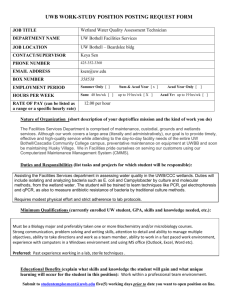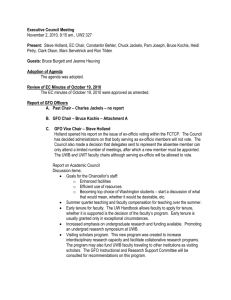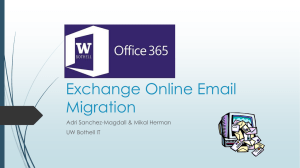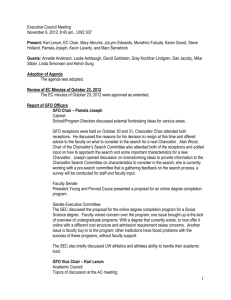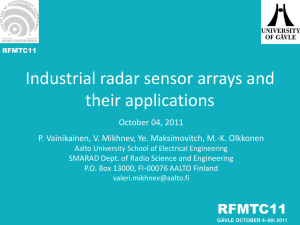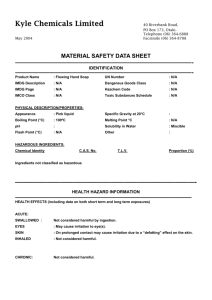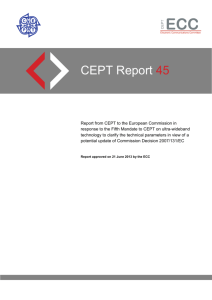3 ITU Radio Regulations Board
advertisement
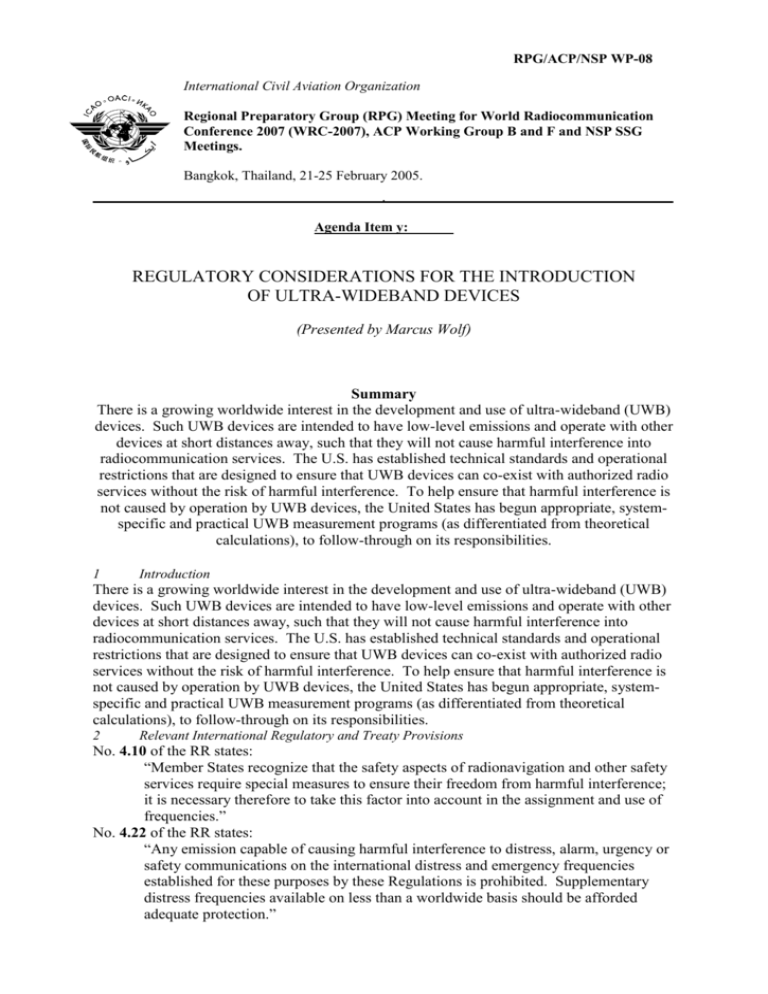
RPG/ACP/NSP WP-08 International Civil Aviation Organization Regional Preparatory Group (RPG) Meeting for World Radiocommunication Conference 2007 (WRC-2007), ACP Working Group B and F and NSP SSG Meetings. Bangkok, Thailand, 21-25 February 2005. . Agenda Item y: REGULATORY CONSIDERATIONS FOR THE INTRODUCTION OF ULTRA-WIDEBAND DEVICES (Presented by Marcus Wolf) Summary There is a growing worldwide interest in the development and use of ultra-wideband (UWB) devices. Such UWB devices are intended to have low-level emissions and operate with other devices at short distances away, such that they will not cause harmful interference into radiocommunication services. The U.S. has established technical standards and operational restrictions that are designed to ensure that UWB devices can co-exist with authorized radio services without the risk of harmful interference. To help ensure that harmful interference is not caused by operation by UWB devices, the United States has begun appropriate, systemspecific and practical UWB measurement programs (as differentiated from theoretical calculations), to follow-through on its responsibilities. 1 Introduction There is a growing worldwide interest in the development and use of ultra-wideband (UWB) devices. Such UWB devices are intended to have low-level emissions and operate with other devices at short distances away, such that they will not cause harmful interference into radiocommunication services. The U.S. has established technical standards and operational restrictions that are designed to ensure that UWB devices can co-exist with authorized radio services without the risk of harmful interference. To help ensure that harmful interference is not caused by operation by UWB devices, the United States has begun appropriate, systemspecific and practical UWB measurement programs (as differentiated from theoretical calculations), to follow-through on its responsibilities. 2 Relevant International Regulatory and Treaty Provisions No. 4.10 of the RR states: “Member States recognize that the safety aspects of radionavigation and other safety services require special measures to ensure their freedom from harmful interference; it is necessary therefore to take this factor into account in the assignment and use of frequencies.” No. 4.22 of the RR states: “Any emission capable of causing harmful interference to distress, alarm, urgency or safety communications on the international distress and emergency frequencies established for these purposes by these Regulations is prohibited. Supplementary distress frequencies available on less than a worldwide basis should be afforded adequate protection.” Article 45 of the Constitution of the ITU addresses Harmful Interference and has three provisions that state: “197 1 All stations, whatever their purpose, must be established and operated in such a manner as not to cause harmful interference to the radio services or communications of other Member States or of recognized operating agencies, or of other duly authorized operating agencies which carry on a radio service, and which operate in accordance with the provisions of the Radio Regulations. “198 2 Each Member State undertakes to require the operating agencies which it recognizes and the other operating agencies duly authorized for this purpose to observe the provision of No. 197 above. “199 3 Further, the Member States recognize the necessity of taking all practicable steps to prevent the operation of electrical apparatus and installations of all kinds from causing harmful interference to the radio services or communications mentioned in No. 197 above.” Number 5.340 of the Radio Regulations states in part: “All emissions are prohibited in the following bands: 1 400-1 427 MHz, 2 690-2 700 MHz, except those provided for by Nos. 5.421 and 5.422, 10.68-10.7 GHz, except those provided for by No. 5.483, … 23.6-24 GHz, ...” Number 13.15 of the Radio Regulations states: “If an administration, or the Board or the Bureau identifies a need for a special study, in relation to the Rules of Procedure, of any provisions of these Regulations or of a regional agreement with an associated frequency allotment or assignment plan, the case shall be handled under No. 13.141. The same shall apply if as a consequence of the review of a finding or other action by the Board if it is necessary to re-examine the Rules of Procedure.” Finally, Number 15.12 of the Radio Regulations states: “Administrations shall take all practicable and necessary steps to ensure that the operation of electrical apparatus or installations of any kind, including power and telecommunication distribution networks, but excluding equipment used for industrial, scientific and medical applications, does not cause harmful interference to a radiocommunication service and, in particular, to a radionavigation or any other safety service operating in accordance with the provisions of these Regulations.” (This provision of the Radio Regulations is footnoted to additionally say that, “In this matter, administrations should be guided by the latest relevant ITU-R Recommendations.”) 3 ITU Radio Regulations Board Like other short range devices which already operate successfully outside radio service allocations, either because they are so low in e.i.r.p. or because of the nature of their emitted spectrum, UWB devices have been authorized to operate in the United States. To ensure compatibility with stations operating in defined radio services, specific limitations apply to UWB devices in a number of frequency bands which include the four specific bands indicated above from No. 5.340 of the Radio Regulations. The U.S. does not give authorization for stations operating in defined radio services in the bands covered by No. 5.340, in respect of its provisions. 1 Number 13.14 of the Radio Regulations gives the procedure for establishing, changing, and using the Rules of Procedure of the Radio Regulations Board. The United States fully agrees with interpretations of Radio Regulations Board with respect to use of the spectrum and, therefore, sees no need to notify the ITU of any UWB operation used on a national basis. The U.S. notes that it is the responsibility of the Radio Regulations Board to interpret the international Radio Regulations when there may be relevant questions raised by administrations or by the Radiocommunication Bureau itself, in implementing the Radio Regulations. 4 National Regulatory Provision The United States, on February 14, 2002, adopted national regulatory provisions2 (regulations), with particularly strict limits to protect GPS, for the implementation of UWB systems. Additionally, the Federal Communications Commission, the U.S. National Aeronautics and Space Administration (NASA), the U.S. Department of Transportation (DOT), the U.S. Department of Defense (DOD), and some commercial entities have been performing, and are continuing to perform relevant emission measurements. As these are completed, the results will be reviewed and published. Furthermore, the FCC intends to continue its review of the U.S. UWB standards to determine where additional changes warrant consideration. To the national development of UWB regulations, the FCC then issued on March 12, 2003, a Memorandum Opinion and Order and Further Notice of Proposed Rule Making3 that declined to make further restrictions on UWB operations beyond those originally imposed in the first FCC UWB Order in 2002. This latter action amended the FCC Rules (a) to facilitate the operation of through-wall imaging systems by law enforcement, emergency rescue and firefighter personnel in emergency situations; (b) to eliminate the requirement that groundpenetrating radars (GPR) and wall imaging systems operate with their -10 dB bandwidths below 960 MHz or above 3.1 GHz; (c) to clarify the limitations on who may operate GPR systems and wall imaging systems and for what purposes; (d) to eliminate the requirement for non-hand held GPR to employ a “dead-man switch”; (e) to clarify coordination requirements for imaging devices; and (f) to clarify the rules regarding emissions produced by digital circuitry used by UWB transmitters. The Further Notice of Proposed Rulemaking portion of this issue requested industry comment on proposed new rules (a) regarding the operation of low pulse repetition frequency UWB systems in the 3.1-10.6 GHz band, including vehicular radars; (b) regarding the operation of frequency hopping vehicular radars in the 22-29 GHz band as UWB devices; (c) regarding the establishment of new peak power limits for wideband devices that do not operate as UWB devices; and (d) regarding the definition of a UWB device. 5 Conclusions The U.S. has adopted national regulatory provisions for the use of UWB devices within its national borders based on specific usage and power level constraints such that these devices would operate without causing harmful to, nor claim protection from harmful interference caused by, stations of other services operating in accordance with U.S. national regulations or the international Radio Regulations. 2 First Report and Order, In the matter of Revision of Part 15 of the [Federal Communication] Commission’s Rules Regarding Ultra-Wideband Transmission Systems, ET Docket 98-153, released April 22, 2002. 3 Copies of the FCC Memorandum Opinion and Order and Further Notice of Proposed Rule Making will be made available by the U.S. Delegation in the Task Group 1/8 meeting room for the convenience of participants.
